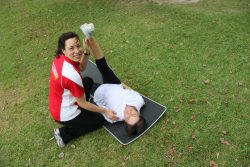
Increasing Circulation
In addition to muscle tension, stress can also restrict blood flow, and this restriction can lead to knots in the muscles, especially those same areas that hold tension like in the shoulders and neck. Stretching increases blood flow to the muscle and aids circulation. Improving circulation allows muscles to relax, relives aches and pains. And can even improve heart and cardiovascular function.
Improved mood
Stretching promotes circulation of new blood to the brain, which can result in mood elevation. Being in a more positive mood will make it easier to allow stress to roll right off your back – avoid accumulating any new stresses, and make it easier to manage current stresses.
Reducing Pain and injury
When muscles and joints are tight, we are more susceptible to pain and injury. Muscles tense up, and we don’t move as freely, or might not want to move at all. Restriction of movement or painful movement can bring on stress simply because it’s harder to get around. It can cause us to miss work or social occasions, adding to stress and decreasing quality of life. Stretching has been shown to increase quality of life, and over time, stretching can reduce fatigue, impatience, lack of sleep, and disability while improving function and assist in eliminating the need for medications.
Deep Breathing
When holding a stretch, people tend to allow the breath to stretch out as well. One of the benefits of deep breathing is to release stress. It promotes full oxygen exchange, which can slow the heartbeat and lower or stabilise blood pressure, inducing a more relaxed state of being.
Slowing Down
Taking time to stretch means taking time out of your busy life to pay attention to your body and slow down. Moving slower allows you to take time to breathe, to notice your surroundings, to pay attention to yourself and decompress. When you are less active, your heart rate slows and you become calmer and less stressed.
The benefits are immediate, and the more you stretch, the better you will feel

